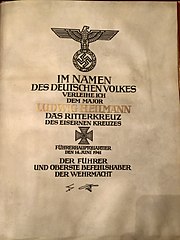| Ludwig Heilmann | |
|---|---|
 | |
| Born | 9 August 1903 |
| Died | 26 October 1959 (aged 56) |
| Place of birth | Würzburg |
| Place of death | Kempten |
| Allegiance |
|
| Service/branch | Luftwaffe |
| Years of service | 1921–1945 |
| Rank | Generalmajor |
| Battles/wars | |
| Awards | Knight's Cross with Oak Leaves and Swords |

Citation for the Knights Cross of the Iron Cross presented to Ludwig Heilmann on 14 June 1941.
Ludwig Heilmann (9 August 1903 – 26 October 1959), was a German Fallschirmjäger and general during World War II. He was also a recipient of the Knight's Cross of the Iron Cross with Oak Leaves and Swords. The Knight's Cross of the Iron Cross and its higher grade Oak Leaves and Swords was awarded to recognise extreme battlefield bravery or successful military leadership.
Military service
Ludwig Heilmann entered the Reichswehr in early 1921. In 1933, having now served for twelve years, left the military service, but after taking a number of courses he was reactivated on 1 July 1934 as an Oberleutnant and commander of the 5th Company, 20th Infantry Regiment. During the Battle of France he won the Iron Cross first class with III Battalion of the 91st Infantry Regiment.
Heilmann joined the parachute troops on 18 June 1940. After various courses and postings Major Heilmann became commander of III Battalion, 1st Parachute Regiment. His battalion was dropped into Crete on 20 May 1941 as part of the first wave. Heilmann's battalion played a part in the German success on the island.
In late autumn 1941 Heilmann and his battalion were sent to Russia, where they fought as infantry. Among the unit's actions was the defense of the Vyborgskaya bridgehead. Heilmann was promoted to Oberstleutnant on 20 April 1942. On 20 August 1943 he became commander of IV Battalion, 3rd Parachute Regiment and on 15 November regimental commander.
After the Allied landing in Sicily Heilmann and his regiment parachuted into the Catania Plain to reinforce "Battle Group Schmalz" of the Fallschirm-Panzer Division 1 "Hermann Göring". His battalion fought near Francoforte and Centuripe near Regalbuto, Bronte and Maletto. On 1 December 1943 Heilmann was promoted to Oberst.
On the Italian mainland Heilmann's regiment fought near Ortona, where on 15 December it ran into an assembly of enemy forces. His I and II Battalions, led by Major Rudolf Böhmler and Hauptmann Gotthart Liebscher, and took Villa Grande. Ortona was held until 28 December.
Heilmann's regiment also took part in the defensive Battle of Monte Cassino. The third battle of Cassino saw it in the focal point of the battle for the monastery mountain.
On 17 November 1944 Ludwig Heilmann became commanding of the 5th Parachute Division, which subsequently fought in the Ardennes. It was here in the south of battlezone where the 5th was ordered to defend the flank from attacks by the U.S. 3rd Army. Heilmann was captured by the Americans just prior to the end of the war and was released in 1947.
Awards
- Wound Badge in Black
- Wehrmacht Long Service Award 4th and 3rd Class (2 October 1936)[1]
- Luftwaffe Parachutist Badge
- Ground Assault Badge of the Luftwaffe
- Iron Cross
- Cuff title "Kreta" (20 May 1943)[1]
- German Cross in Gold on 26 February 1942 as Major in the III./Fallschirmjäger-Regiment 3[2]
- Knight's Cross of the Iron Cross with Oak Leaves and Swords
Notes
References
- Citations
- Bibliography
- Berger, Florian (1999) (in German). Mit Eichenlaub und Schwertern. Die höchstdekorierten Soldaten des Zweiten Weltkrieges [With Oak Leaves and Swords. The Highest Decorated Soldiers of the Second World War]. Vienna, Austria: Selbstverlag Florian Berger. ISBN 978-3-9501307-0-6.
- Fellgiebel, Walther-Peer (2000) (in German). Die Träger des Ritterkreuzes des Eisernen Kreuzes 1939–1945 – Die Inhaber der höchsten Auszeichnung des Zweiten Weltkrieges aller Wehrmachtsteile [The Bearers of the Knight's Cross of the Iron Cross 1939–1945 — The Owners of the Highest Award of the Second World War of all Wehrmacht Branches]. Friedberg, Germany: Podzun-Pallas. ISBN 978-3-7909-0284-6.
- Kurowski, Franz (1995). Knights of the Wehrmacht Knight's Cross Holders of the Fallschirmjäger. Atglen, PA: Schiffer. ISBN 978-0-88740-749-9.
- Patzwall, Klaus D.; Scherzer, Veit (2001) (in German). Das Deutsche Kreuz 1941 – 1945 Geschichte und Inhaber Band II [The German Cross 1941 – 1945 History and Recipients Volume 2]. Norderstedt, Germany: Verlag Klaus D. Patzwall. ISBN 978-3-931533-45-8.
- Schaulen, Fritjof (2003) (in German). Eichenlaubträger 1940 – 1945 Zeitgeschichte in Farbe I Abraham – Huppertz [Oak Leaves Bearers 1940 – 1945 Contemporary History in Color I Abraham – Huppertz]. Selent, Germany: Pour le Mérite. ISBN 978-3-932381-20-1.
- Scherzer, Veit (2007) (in German). Die Ritterkreuzträger 1939–1945 Die Inhaber des Ritterkreuzes des Eisernen Kreuzes 1939 von Heer, Luftwaffe, Kriegsmarine, Waffen-SS, Volkssturm sowie mit Deutschland verbündeter Streitkräfte nach den Unterlagen des Bundesarchives [The Knight's Cross Bearers 1939–1945 The Holders of the Knight's Cross of the Iron Cross 1939 by Army, Air Force, Navy, Waffen-SS, Volkssturm and Allied Forces with Germany According to the Documents of the Federal Archives]. Jena, Germany: Scherzers Miltaer-Verlag. ISBN 978-3-938845-17-2.
- Thomas, Franz; Wegmann, Günter (1986) (in German). Die Ritterkreuzträger der Deutschen Wehrmacht 1939–1945 Teil II: Fallschirmjäger [The Knight's Cross Bearers of the German Wehrmacht 1939–1945 Part II: Paratroopers]. Osnabrück, Germany: Biblio-Verlag. ISBN 978-3-7648-1461-8.
- Thomas, Franz (1997) (in German). Die Eichenlaubträger 1939–1945 Band 1: A–K [The Oak Leaves Bearers 1939–1945 Volume 1: A–K]. Osnabrück, Germany: Biblio-Verlag. ISBN 978-3-7648-2299-6.
External links
| Wikimedia Commons has media related to Ludwig-Sebastian Heilmann. |
- Ludwig Heilmann @ Lexikon der Wehrmacht
- Ludwig Heilmann @ ISLAND FARM SPECIAL CAMP: XI POWS HELD AT BRIDGEND
| |||||||||||
The original article can be found at Ludwig Heilmann and the edit history here.
